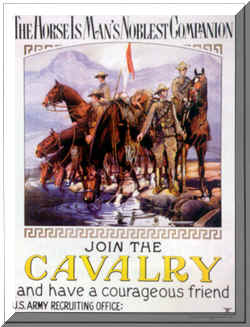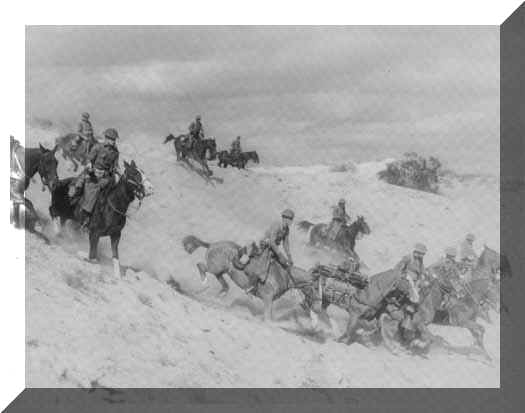
Scout History and Traditions

Cavalry: A unit of soldiers mounted on horseback; from the French word cavalerie and the Latin word callabus, meaning horse.
The US Cavalry is a complex, versatile force designed for missions of reconnaissance and security. It was born during the American Revolution when General George Washington authorized the creation of six regiments of Continental Dragoons, which quickly became elite elements of the Continental Army. Unfortunately, the cavalry was deactivated at war's end, mainly for budgetary reasons. The American Army went forty years without a cavalry.
Increased westward expansion brought confrontations with Indians and a regular force of cavalry was necessary to maintain order and protect settlers on the open plains. The First Regiment of US Dragoons was authorized by Congress. The cavalry was so successful against the Indians and in the 1848 war with Mexico that their role grew quickly. By 1860, six regular regiments were serving in the West.
During the American Civil War (1861 - 1865), the cavalry performed a variety of functions including mounted charges, security operations, and reconnaissance. The cavalry did not often stage a conventional attack. The biggest cavalry engagement of the Civil War took place in 1863 with over 50,000 mounted soldiers engaged in battle. Following the Civil War, it became apparent the Indians had taken advantage of the distraction and had greatly increased their resistance to the settlement of the West. In response, Congress increased the number of regular cavalry regiments to ten. Two of the regiments, the Ninth and the Tenth, were made of former black slaves, who became known as the "Buffalo Soldiers" by the Indians. The ten cavalry regiments found plenty of action on the frontier from 1866 until 1888.

The Indian Wars were characterized by small vicious engagements, the most famous of which was General Custer's fight at Little Big Horn River in Montana. Custer's 600-man 7th Cavalry was virtually wiped out by a band of 4,000 Sioux led by chiefs Crazy Horse and Sitting Bull. In 1911, Mexican bandits led by the famous revolutionary Pancho Villa staged raids on towns throughout Texas and New Mexico. The entire regular cavalry force, 15 regiments, was deployed to guard the border. In 1916, after a devastating attack, General "Black Jack" Pershing led several thousand cavalrymen into Mexico in pursuit of the bandits. General Pershing's raid into Mexico was significant for two reasons: it mobilized over 400,000 US troops who were then available when the US entered World War I, and more significantly for the mounted force, it was the last large scale military operation of the US cavalry on horseback.
In 1917, the US cavalry forces deployed to France and entered the war as couriers. Following the war a slow but steady reduction took place in the cavalry forces. The one hundred year old 1st US Cavalry Regiment was dismounted and mechanized in 1933. Mechanization of the Army's seventeen regiments began in 1941 and all units were dismounted by the end of the following year.
 World
War II saw the birth of the US Armored Force and Armored
Cavalry. The cavalry was reorganized into armored and
mechanized regiments. Both types share the traditions
of the horse-mounted force and the branch color
yellow. The cavalry has continued to serve in all
major military engagements throughout history. Ten
cavalry squadrons and a cavalry regiment participated in
Vietnam, while air cavalry participated in the Grenada and
Panama invasions. Most recently, two armored cavalry
regiments, two air cavalry squadrons, and seven ground
cavalry squadrons took part in Operation Desert Storm.
Today's cavalry constantly evolves to meet the demands of
the modern battlefield. It is strong enough to engage
in decisive combat to achieve the goal of destroying the
enemy's cohesion and will to fight. The US Cavalry is
specifically designed and equipped to conduct its mission on
short notice, anywhere in the world.
World
War II saw the birth of the US Armored Force and Armored
Cavalry. The cavalry was reorganized into armored and
mechanized regiments. Both types share the traditions
of the horse-mounted force and the branch color
yellow. The cavalry has continued to serve in all
major military engagements throughout history. Ten
cavalry squadrons and a cavalry regiment participated in
Vietnam, while air cavalry participated in the Grenada and
Panama invasions. Most recently, two armored cavalry
regiments, two air cavalry squadrons, and seven ground
cavalry squadrons took part in Operation Desert Storm.
Today's cavalry constantly evolves to meet the demands of
the modern battlefield. It is strong enough to engage
in decisive combat to achieve the goal of destroying the
enemy's cohesion and will to fight. The US Cavalry is
specifically designed and equipped to conduct its mission on
short notice, anywhere in the world.